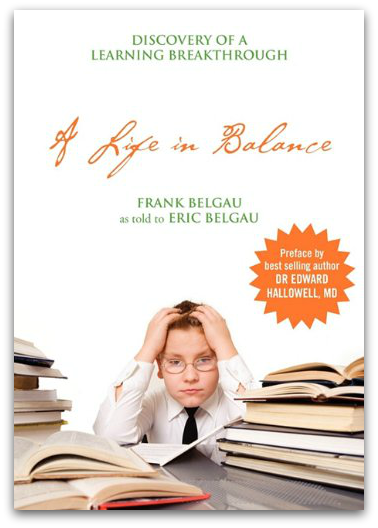
The Learning Breakthrough Program sent me a PDF copy of their book called A Life in Balance by Frank Belgau as told to Eric Belgau, his youngest son. I recently went to a presentation on balance boards, and I was definitely intrigued. And then along came the opportunity to read this book! I love when things come together like this.
The book has about 196 pages, and is a fairly quick and interesting read. Frank Belgau opens the book with some insight into his childhood learning struggles. Reading did not come easy, and running usually ended up with his tripping over his own two feet. He was determined to overcome at least the running issue, so he spent an entire summer on the beach performing running drills he thought up. Not only did he manage to overcome this, but by the end of the summer, he discovered he was also able to read. Academics came easier for him after that.

Throughout his life, Frank encountered various people who inspired, challenged, and encouraged him as he sought to help children with learning disabilities. As a teacher, he literally turned his classrooms into a lab where he tested idea after idea. He encouraged the children to give him feedback which in turn forced him to throw out what wasn’t working, and hunt for more things that did. His first, real breakthrough came along when he used a swinging pendulum ball in his classroom. One of his students had a definite change in his speed, clarity and inflection when he read after doing the pendulum exercises.
A Life in Balance mostly tells the story of Frank’s discoveries that led to his final program, but he also discusses some of the science at work in the human brain, how balance on both sides of the body is important for learning, and at the end of the book, he even shares some activities you can try at home–like the Shadow Walk.
Click through to the blog if you can’t see the video.
As I read through the book, especially when he delved a little into the brain, I was reminded of the review I wrote last year called Understanding Child Brain Development. I believe that the best way to help someone is by focusing on them as a whole. Our learning is definitely affected by how well our bodies are functioning. Frank figured out that balance between the two sides of the body played an important role in learning. He’s developed what looks to be an amazing program, one I got to see up close in that workshop, and if I could afford it, I would already have it. You don’t know how much I wish I could review it. I have an adult daughter who appears to struggle with dyslexia, a couple of my kids who have ADHD (including yours truly), and Alzheimers and Parkinsons runs through my family. I’m already struggling with some memory issues. I truly believe the things I’ve learned both from that other review, and this one, are valuable to our family.
Not only will we incorporate the activities in the back of the book, but I’m also looking into various ways to address balance, coordination, etc. And at some point, I hope I can invest in this program. I think the kids would enjoy the challenges as well as discover that they help. I find myself, once again, frustrated with an educational system that has dismissed this program. The lady who gave the presentation said the school system used to use the things in this Learning Breakthrough Program kit, but stopped due to cost or time. Really? Something that has helped so many? Grr. If I ever get this kit in my hands, I have a feeling I’d be giving lots of demonstrations. I find this absolutely fascinating and exciting.

I’d encourage you to read this especially if you have children who struggle with learning disabilities. When you read about his life, you can’t help but see how things fell into place to lead him to his final Learning Breakthrough Program. The book shares some inspiring stories about children he’s helped, and even gave me a couple of things to consider in my parenting. For example, I was reminded that kids genuinely want to learn, that we shouldn’t over-praise our children, but reserve it for real praiseworthy moments (and they can tell when that is), and that we should set the bar high, so they reach higher. I don’t mean have high expectations, but rather give them something to shoot for, and don’t underestimate their abilities.
My only con: There were some editing issues, and the writer in me growled a little, but they don’t detract from the overall message in the book.
A Life in Balance (paperback) costs $16.94.
You can also find Learning Breakthrough on Facebook, Twitter, and YouTube.

